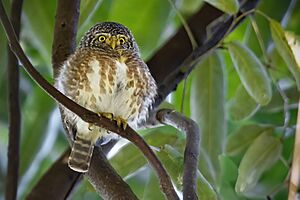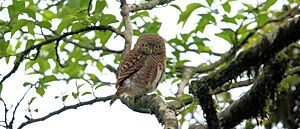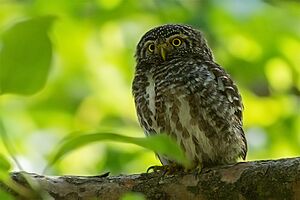Collared owlet facts for kids
Quick facts for kids Collared owlet |
|
|---|---|
 |
|
| Conservation status | |
| Scientific classification | |
| Genus: |
Taenioptynx
|
| Species: |
brodiei
|
The collared owlet (Taenioptynx brodiei) is a tiny owl found across Asia. It's also called the collared pygmy owl. This little bird lives in mountain forests with open areas. It's the smallest owl in Asia, usually about 15 cm (5.9 in) tall and weighing around 60 g (2.1 oz).
Contents
Discovering the Collared Owlet
The collared owlet was first officially described in 1836. An English zoologist named Edward Burton gave it the name Noctua brodiei. Later, scientists studied its DNA and found it was closely related to other small owls. These include the jungle owlet and the Asian barred owlet.
There are two main types, or subspecies, of the collared owlet:
- T. b. brodiei: Found from the Himalayas to southern China, and through Indochina and the Malay Peninsula.
- T. b. pardalotus: Found in Taiwan.
Another owl, the Sunda owlet, used to be considered a type of collared owlet. But in 2019, after studying their calls, scientists decided it was its own separate species.
What Does a Collared Owlet Look Like?
The collared owlet is the smallest owl in Asia. It stands about 15 to 17 cm tall. Female owlets are usually a bit bigger than males. Females weigh about 63 grams, while males weigh around 52 grams.
These owls are mostly grey-brown. Their backs and sides have stripes, but their heads have more spots. They have bright yellow eyes and white eyebrows. A white patch is also visible on their throat. The chest and belly are mostly white.
One cool thing about them is the "occipital face." This means they have a pale collar and two black spots on the back of their neck. These spots look like eyes, making it seem like the owl is watching you from behind! This might help trick predators. Unlike some other owls, they don't have ear tufts. When they fly, you can see their tail, which is longer than many other pygmy owls. They also flap their wings very fast.
Changing Colours: Owl Morphs
Collared owlets can change their colour as they grow up. This is called a "colour morph." Scientists in Taiwan studied this by catching and releasing the same owls.
- When an owl was about 56 days old, it looked like a young bird. It had fewer spots and stripes. Its "occipital face" wasn't fully formed yet.
- At 165 days old, the same owl had changed to a reddish-orange colour. This is called a "rufous morph." It had more stripes and spots, and its fake eyes were fully formed.
- By 394 days old, the owl was in its final grey colour. This is the "grey morph."
Owl Calls and Sounds
Collared owlets have very unique calls. The male owl makes a special four-note sound: "wüp-wüwü-wüp". He repeats this every few seconds. Sometimes, his call might be shorter, ending in "wüwü".
Their calls start soft but get louder and more excited. The owl turns its head in all directions while calling. This makes it sound like the noise is coming from different places, making it hard to find the bird!
Where Do Collared Owlets Live?
The collared owlet stays in its home area all year round. It doesn't migrate.
Owl Homes and Habitats
You can find these owls in a very large area. Their range stretches from the Himalayas in northern Pakistan all the way to eastern China and Taiwan. They also live south through Malaysia.
Countries where the collared owlet lives include:
- Bhutan
- Brunei Darussalam
- Cambodia
- China
- India
- Laos
- Malaysia
- Myanmar
- Nepal
- Pakistan
- Taiwan
- Thailand
- Viet Nam
Preferred Living Spaces
Collared owlets like different kinds of forests. They live in evergreen forests, along forest edges, and in mixed forests with trees like oak, rhododendron, and fir. They also like open woodlands with bushes.
These owls usually live in mountains, between 1350 and 2750 meters high. But sometimes, they are seen closer to farms as low as 700 meters.
Collared owlets don't build their own nests. Instead, they use natural holes in trees or holes made by other birds like woodpeckers and barbets.
How Collared Owlets Live
The collared owlet is mostly active during the day. This means it is a diurnal bird. You can often see them sitting on branches, hunting, and calling throughout the day. Sometimes, they are active at night too. Other small birds often bother them when they are resting.
Breeding and Raising Young
Not a lot is known about how collared owlets reproduce. But it's thought that a male and female owl only stay together during the breeding season. This usually happens from March to April.
They nest in tree hollows or old woodpecker holes. These spots are often in rotten trees, high up, in a clearing or open part of the forest. A female owl usually lays 3 to 5 eggs. The eggs are round and white. They are laid between late April and mid-June. The young owls leave the nest from mid-June to early August.
What Do Collared Owlets Eat?
Scientists haven't studied the exact diet of the collared owlet much. But we can guess it eats similar things to its close relative, the jungle owlet.
The jungle owlet hunts small animals like:
- Small mammals: house mice, little Indian field mice, brown spiny mice, and white-toothed pygmy shrews.
- Reptiles: Such as skinks.
- Birds
- Amphibians
- Many invertebrates (like insects)
So, the collared owlet likely eats small birds, insects, lizards, and small mammals. Even though they are small, these raptors are very fierce! They have even been seen catching prey as big as themselves. Once they catch their food, they take it to a perch using their talons. Then, they tear it apart with their beak.
Collared Owlet Status
The collared owlet is listed as a species of "least concern" by the IUCN Red List. This means it's not currently in danger of disappearing. However, its biggest threat is losing its habitat.
A study looked at how breaking up forests affects night birds in Asia. It found that collared owlets were never seen in forest areas smaller than 100 hectares. This suggests that human activities, like deforestation (cutting down forests), can harm even small species like the collared owlet.




